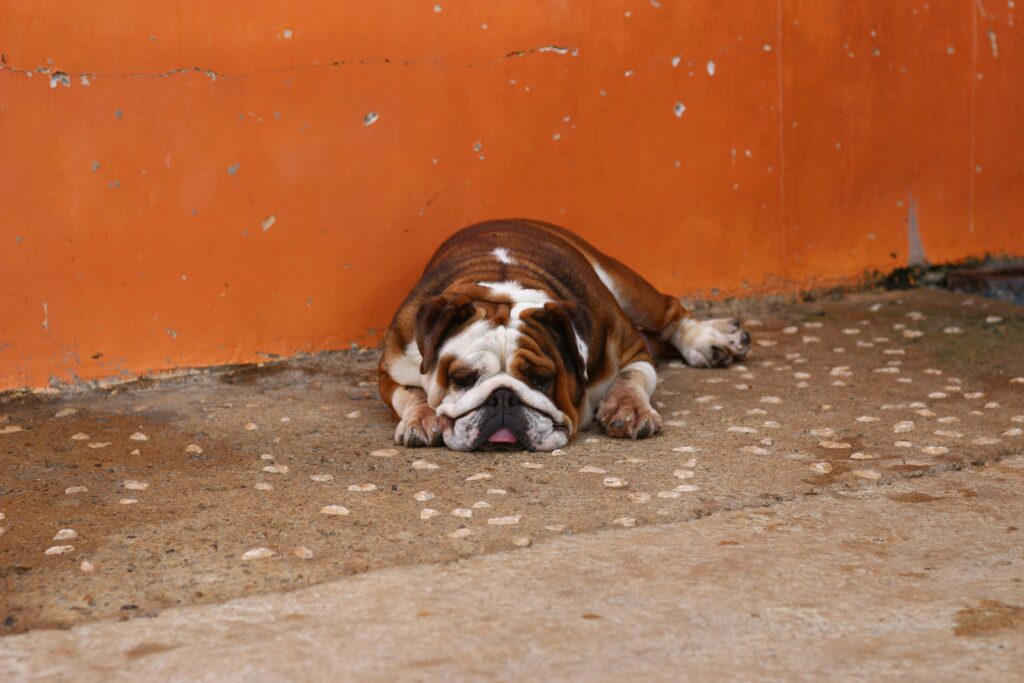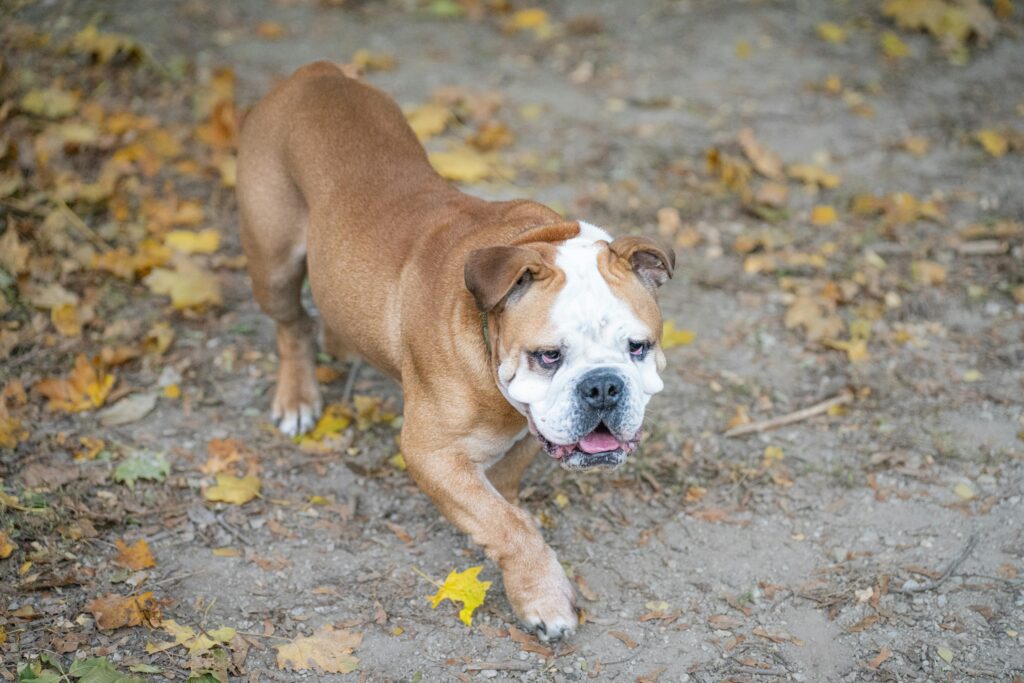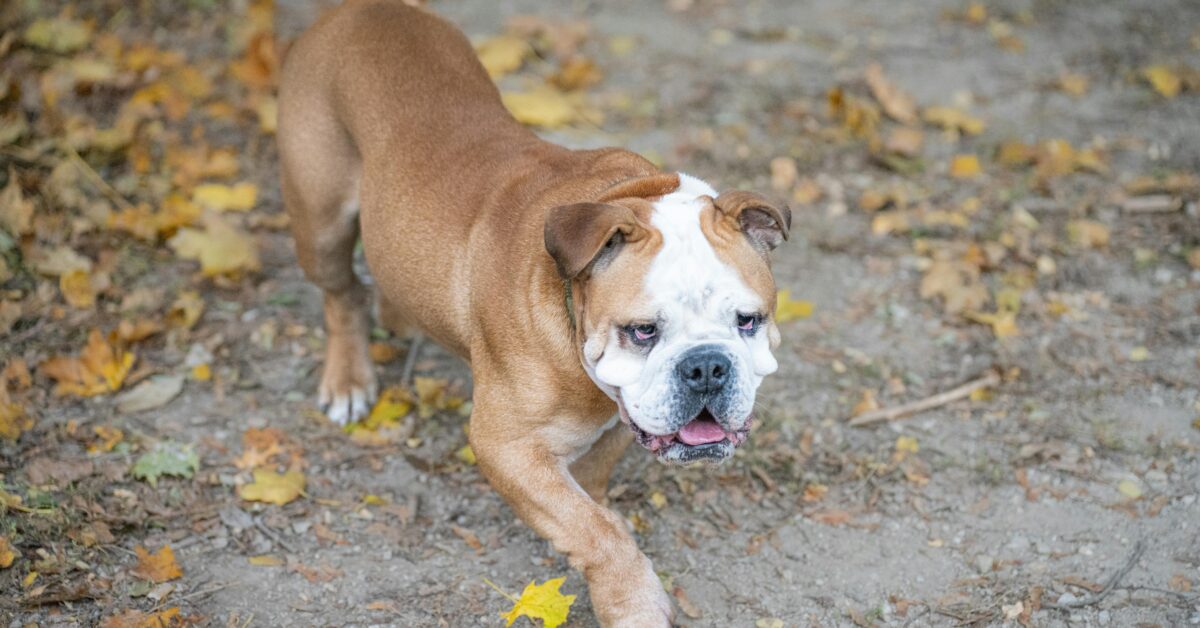A reader sent in the following question, so we thought it was a good time to take a deep dive into the answer: “Why is my bulldog limping?” It’s never nice to see signs of your pampered pooch in pain or discomfort, but the one good thing you should take from it is this: you have noticed a problem; therefore, you can now fix it.
Today, we’re going to look at every single possible reason why your bulldog might be limping when you should start worrying and take them to the vet, and the tricks you can use to keep them comfortable and pain-free at home.
So, without any further ado, let’s dive right in and find out what might be the cause of your bulldog limping, shall we?
Why is my bulldog limping?
There are literally hundreds, maybe even thousands of reasons why your British bulldog might be limping, but today, we’re going to take a closer look at the most common ones – and some of them might just surprise you.
A limp doesn’t always mean something serious… but you can’t always rule out the more serious causes until a professional (aka a vet) performs examinations and tests that only they can do.
Allow me to explain…
Muscle strain or fatigue
Have you ever been to the gym, worked on your leg muscles for an hour so, then gone to bed, not thinking anything of it, only to wake up barely managing to move your legs at all? You have used your leg muscles, and they are tired and/or overused.
This more likely happens when you haven’t been to the gym for a while, or you’ve worked out especially hard, right? Well, the same could apply to your British bulldog – and let’s be honest, some of them aren’t exactly known for exerting themselves, are they?
Your bully could be limping because they have overused a leg muscle. As a result, muscle strain, a sprain, or even plain ol’ fatigue could be the cause.
Bruising
In the same way that you – the pet parent – can get bruises from a bump or fall throughout the day, your bulldog can get bruised from bashing, bumping, or flying into something.
Bruises often leave a visible sign – an actual bruise. This isn’t always obvious on your dog’s skin, though.

Keep an eye out for any of the following signs and symptoms that might accompany a bulldog bruise and limping:
- Redness
- Swelling
- Tenderness (and touch avoidance)
- Excessive licking in one affected area
- Cuts or wounds
- Discharge – blood, pus, weeping
Something stuck in paw
There are lots of little nooks and crannies in your bulldog’s paw, all of which have the potential to act as traps for dirt, debris, and other things to get stuck in. If your bulldog has suddenly started limping, take a closer look at their paws for things like:
- Sand
- Dirt
- Stones
- Twigs
- Grass seeds
- Pine needles
- Acorns
- Thorns
- Leaves
- Carpet or fabric fibres
- String, thread, or rope
- Dust or lint
- Glitter or beads
- Wood chips, shavings, or splinters
- Shards of glass
- Metal shavings
- Bits of plastic
- Food crumbs
- Kids toys/parts of
In many cases, once the foreign item has been removed from your bulldog’s paw, and any irritation is left to heal, the limp will likely go away. The problem is now solved, after all.
If you are unable to move the foreign object – or even find it – then it’s time to call your vet for help. The longer you leave a splinter or other foreign object in your pet’s paw, the higher the chances of them developing a dangerous bacterial infection, which, if left untreated, can lead to quick and sudden death.
I recommend taking a peek at Top 10 Paw Cleaners for Bulldogs for high-rated, well-reviewed paw cleaners for your pampered pooch!
Burned paws (summer)
If you can’t leave your bare hand on the hot ground for more than ten seconds, on a summer’s day, then it is too hot for your bulldog’s paws to be on the ground.
Hot air temperatures can lead to even hotter, close to burning ground temperatures, especially on pavements (concrete/asphalt) and sand. If your pup’s paws get burned, they won’t want to put pressure on it, which can cause limping, touch avoidance, and other signs of your bulldog being in pain.
If you suspect that your bulldog’s paws are burned or otherwise affected by the hot temperatures, take them to the vet immediately. Just because you can’t see burning or sore paws, doesn’t mean they’re not there.
For more information on safe (and not safe) temperatures for bulldogs, check out Bulldogs and Heat: 10 Tips & Crucial Details.
Frozen paws (winter)
In much the same way that your bulldog’s paws can get burned in the summer, they can also get too cold and frozen in the winter. If the air temperature is 0°C (32°F,) your bulldog’s blood vessels start to get smaller, known as constricting. Over time, the narrowing means that less and less blood gets to the area, causing what we humans know as frostbite.

As with humans, where the toes and fingers are often affected first, dogs will likely experience frostbite first in the tail, paws, ears, and possibly nose.
If you think that your bulldog’s paws have been affected by the cold weather, even in a small and minor way, get them checked out by a vet. It’s better to be safe rather than sorry!
Paw inflammation
If your bulldog has allergies, which so many of the breed do, there’s a high chance that they’ll be excessively licking one area of the body – probably the paws, or one paw. All of that excessive licking can cause injuries and pain, including soreness, bleeding, and even balding patches.
Bulldogs tend to have a “hypersensitive” immune system, which basically means that it freaks out and overreacts to things that other dog breeds probably wouldn’t have a problem with. Grass, pollen, certain foods (i.e. chicken,) dust, cleaning products, and more can all cause allergies in bulldogs, which can, in turn, lead to sore paws and limping.
For more information, I recommend checking out Bulldog Eczema: The Pet Parents Essential Guide.
Nail trauma or damage
If your bulldog has hurt their nail in some way, they’re not going to want to put pressure on it – which, in turn, leads to limping. One of the first thing you should do when you spot your bulldog limping or avoiding using one limb is check their paws and nails. Nail trauma or damage is fairly common and happens as a result of boisterous playing, slips and falls, and other little accidents.
Look for signs of broken nails, redness or swelling, any oozing or pus, dried or fresh blood, matted fur, fur loss, and objects stuck in your dog’s nails.
If nail trauma or damage is the cause of your bully’s limping, removing the problem and letting the trauma heal will usually rectify the whole situation.
Interdigital cysts
Interdigital cysts aren’t actually true cysts at all, but they are just as painful, just as debilitating, and just as awful to watch your beautiful bulldog go through.
Also known as interdigital furuncles, interdigital cysts are painful, inflamed lumps or boils that form between your bulldog’s toes. They’re actually more like abscesses or nodules than true cysts, and they often contain pus or blood.
Stocky, short-haired, heavy breeds are more prone to suffering from interdigital cysts, such as English bulldogs, French bulldogs, and pugs.
This is due to several reasons, including:
- Bristly, short hair
- Abnormal gait/posture
- Compact feet
- Wrinkled feet
- More prone to allergies
You can find more information on interdigital cysts here: Interdigital Cysts in Bulldogs: What Pet Parents Should Know.
Insect stings and bites
Bee stings, wasp stings, spider bites, and all manner of other bug stings and bites can afflict your four-legged friend, and especially in the summer. You should check for potential sting and bite sites on your bulldog’s paws if they appear to be limping. There isn’t always a visible and obvious bite or sting puncture hole, so if you’re not sure, get your bully checked by a vet.
Bulldogs can experience allergic reactions to bee/wasp stings and other insect stings or bites in the same ways that humans can.
Tick-borne disease
Lyme disease is just one tick-borne disease that bulldogs can get, and it can cause limping in one or more limbs alongside various other symptoms, including:
- Swollen lymph nodes
- Leg dragging
- Diarrhoea and vomiting
- Weight loss
- Increased water intake
- Reduced food interest
- Lethargy/tiredness
- Swelling
- Redness
- Tenderness
- Unusual behaviour, such as snapping or growling
- High temperature (fever)
Lyme disease is spread by the bite of an infected tick, and, thankfully, it’s not very common in the UK – but is increasing, according to reports. Research has shown that as many as four percent of all ticks in the UK are infected, with a maximum of five percent of all tick bites going on to test positive for Lyme disease.
You can find more information about bulldogs and Lyme disease right here.
Infections
Fungal, bacterial, and viral infections can affect your bulldog’s paws, causing them to become painful to walk on and, in turn, a limp. These infections usually need to be diagnosed by a vet following blood tests, urine tests, and other examinations.
Treatment for infections will usually focus on the infection itself, such as antibiotics, with secondary treatments for secondary issues. These might include topical steroid treatments for heavily affected spots.
If you think your bulldog might have an infection in or around their paws, it’s time to make an appointment with your local vet. Unfortunately, without diagnosis, the proper treatment can’t be given. Anything you try will be, at best, a guess.
Knee and tendon injury or damage
Bulldogs are prone to knee injuries and damage because of their heavy weight and stocky build, especially as they grow in age. The most common knee injuries for the breed include:
- Patellar luxation – the equivalent of a dislocated knee cap in humans
- CCL injury – the equivalent of an ACL injury in humans (particularly athletes)
- Arthritis – commonly found in middle aged and older dogs, also known as degenerative joint disease
Hip dysplasia
Hip dysplasia is a genetic skeletal condition where the hip joint doesn’t fit together properly. The ball (femur head) and socket (hip socket) are misaligned, which causes joint instability, pain, and eventually arthritis.
This is well-known condition for bulldogs, unfortunately – again, for several reasons.
These include:
- Selective breeding
- Heavy body, particularly upper body
- Wide stance
- Abnormal posture
- Stocky breed
- Brachycephalic breed
Bulldogs with hip dysplasia tend to walk and run slightly differently, known as “bunny hopping.” You might also notice other symptoms such as limping, dragging a leg, stiffness, loss of muscle, decreased activity, decreased interest in play and toys, and trouble getting around.
Alongside hip dysplasia, elbow dysplasia can also cause your bulldog to have a limp. Rather than in the hips, however, the problem is located in the elbows.
Spondylosis
Spondylosis is another of the medical conditions that bulldogs tend to suffer with – and with this one, middle-to-late aged dogs are affected the most. Young pups can still develop it, however, usually as a result of trauma to the spine or a genetic deformity.
Studies have shown that spondylosis is closely linked to malformed vertebrae, and studies show that as many as 78.6% of all bulldogs had some degree of vertebrae deformation.
This condition is degenerative, which means that it will get worse as time progresses.
Initial symptoms include:
- Difficulty getting up from lying or sitting positions
- Slower movements than normal
- Stiff limbs and/or body
- Walking with a limp
- Dragging leg(s)
- Inability to climb or go down stairs
- Reduced activity, particularly jumping (i.e. on couch)
- Changes to spine shape – curving, hunching, arching
- Toilet troubles – urinary and defecation incontinence
Bone fractures
English or British bulldogs have quite a unique bone structure, with short legs, a stocky body, and very broad shoulders. This makes them look super cute, sure… but it can also create a whole host of problems for their poor little bones.
Bulldogs are more prone to bone fractures due to congenital bone disorders, such as osteochondrodysplasia; lower activity levels than other dog breeds; elbow and hip dysplasia problems; and a higher weight-to-shape ratio, which puts a lot of extra pressure on the bones.
The most common types of bone fractures in bulldogs are:
- Radius/ulna (forearm)
- Femur (thigh bone)
- Pelvis
- Spinal
- Skull
The symptoms of bone fractures in British bulldogs will depend heavily on the specific bone that has been fractured. You’ll likely notice things like limping, excessive licking or scratching in one specific spot, physical signs and also sounds of pain, yelping, moving less than usual, and visible deformities or swelling.
Bone tumour
Bone tumours are one of the most common types of cancer in all dog breeds, including bulldogs. Heavy, large, and stocky breeds are the worst affected, such as rottweilers and great Danes.
Some studies show that osteosarcoma, a type of bone tumour, accounts for more than 85% of all types of bone cancer, and one of the very first symptoms is often lameness or a limp, particularly in one leg.
It is essential that you seek advice from a vet as soon as you see your bulldog with a limp. The problem might be benign and nothing serious at all, but it could also be something like bone cancer, which can and will spread to other parts of the body if left untreated. This is known as metastasising and as you might expect, it makes the cancer much, much more difficult to treat.
Panosteitis
Some experts will refer to panosteitis as pano or “growing pains,” which is, essentially, what they are. The longer bones of bulldogs and other heavy, fast-growing dog breeds are mostly affected, such as the legs – and it causes inflammation that can be both painful and debilitating.
Alongside bulldog limping, panosteitis trends to happen between five months and one year of age, but can occur a little either side.
Males are diagnosed more often than female bulldogs, and it usually goes away once the pup has stopped growing – but it can also affect dogs that aren’t still in the growing stage of life, just to make things super difficult and complicated!
FAQs
Can you give an English bulldog human painkillers for limping?
No. Absolutely not. English bulldogs (and other dog breeds) should not have human medications, ever, unless they have been specifically and deliberately prescribed by a vet that knows and has examines your pup.
Human medications are often toxic to dogs, and the outcome could be fatal.
Some human medications are safe for bulldogs, but they are prescribed following a thorough investigation, including measuring your doggo’s weight. When they are prescribed, human medications are measured as a certain amount of the painkiller for every kilogram or pound of your pet’s weight.
How long should you let a bulldog limp before you see a vet?
If your English bulldog is limping for more than 24 to 48 hours, you should definitely contact your vet. You should seek immediate assistance if your bulldog’s limp has come on suddenly, is very severe, they’ve recently had an accident or fall, you can see physical deformities or swelling, or your dog is crying or showing other signs of pain and discomfort.

English bulldog limping: Conclusion
Although your bulldog’s limp might be nothing serious at all, it’s always better to get them checked over by a vet to be on the safe side. Yes, your bully could be bruised… but what if the limp is actually a symptom of something much more serious?
A vet will be able to investigate, then tell you, one way or the other, what’s going on with your doggo’s health.



